Case Study on Occupiers' Liability Act: Charlie Chocolate Factory
VerifiedAdded on 2023/06/18
|7
|1663
|218
Case Study
AI Summary
This case study analyzes the liabilities of Charlie Chocolate Factory under the Occupiers' Liability Act in two distinct scenarios. The first case involves a ten-year-old child, Terry, who enters a restricted area and sustains injuries. The analysis considers the duty of care owed to children and the responsibility of guardians. The second case examines an adult, Jessica, injured due to a malfunctioning train ride. This explores the factory's duty of care towards visitors and the concept of acceptance of risk concerning personal property damage. The study references relevant sections of the Occupiers' Liability Act 1957 and the Occupational Liability Law 1984, ultimately determining the factory's liability in each situation based on negligence and visitor awareness.
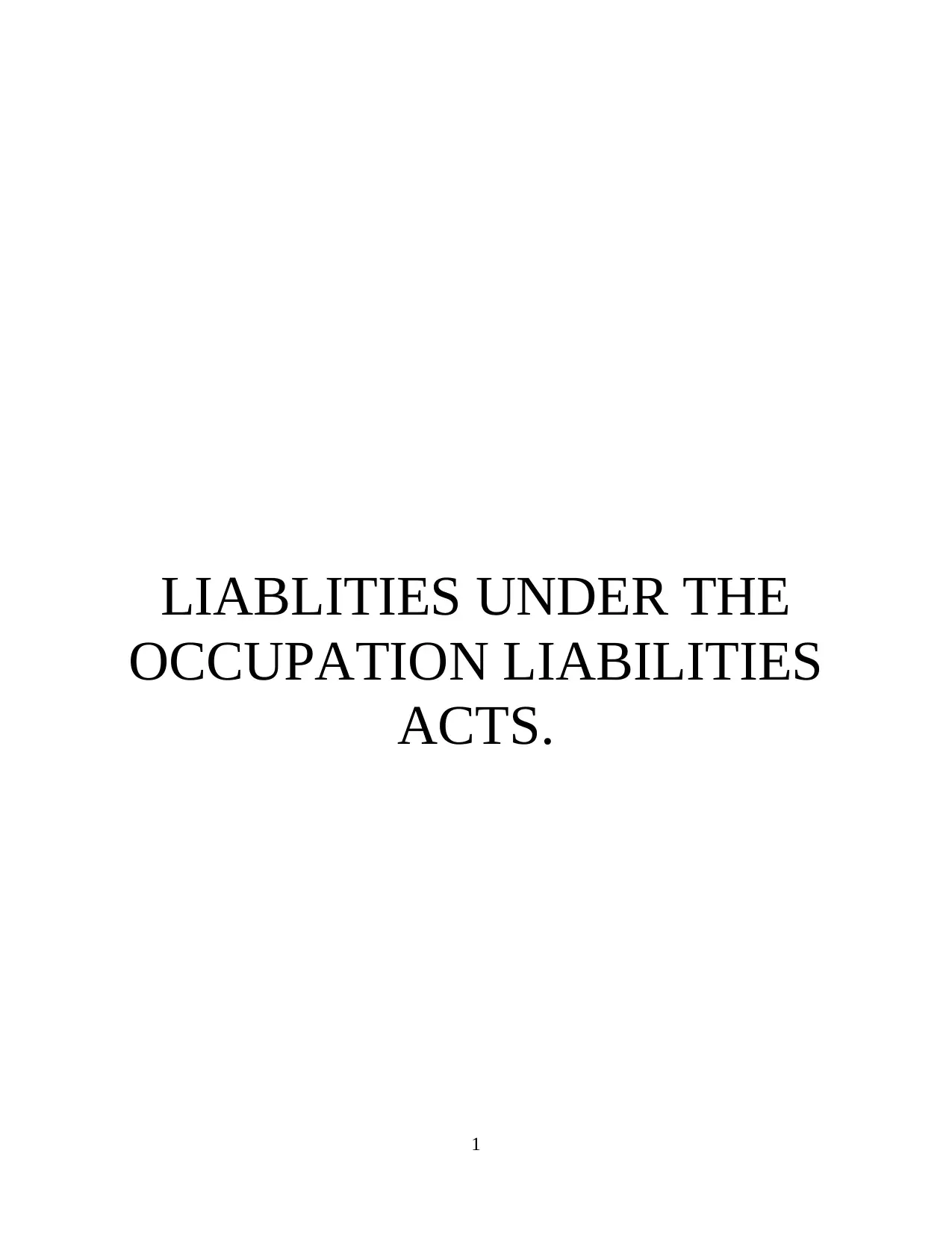
LIABLITIES UNDER THE
OCCUPATION LIABILITIES
ACTS.
1
OCCUPATION LIABILITIES
ACTS.
1
Paraphrase This Document
Need a fresh take? Get an instant paraphrase of this document with our AI Paraphraser
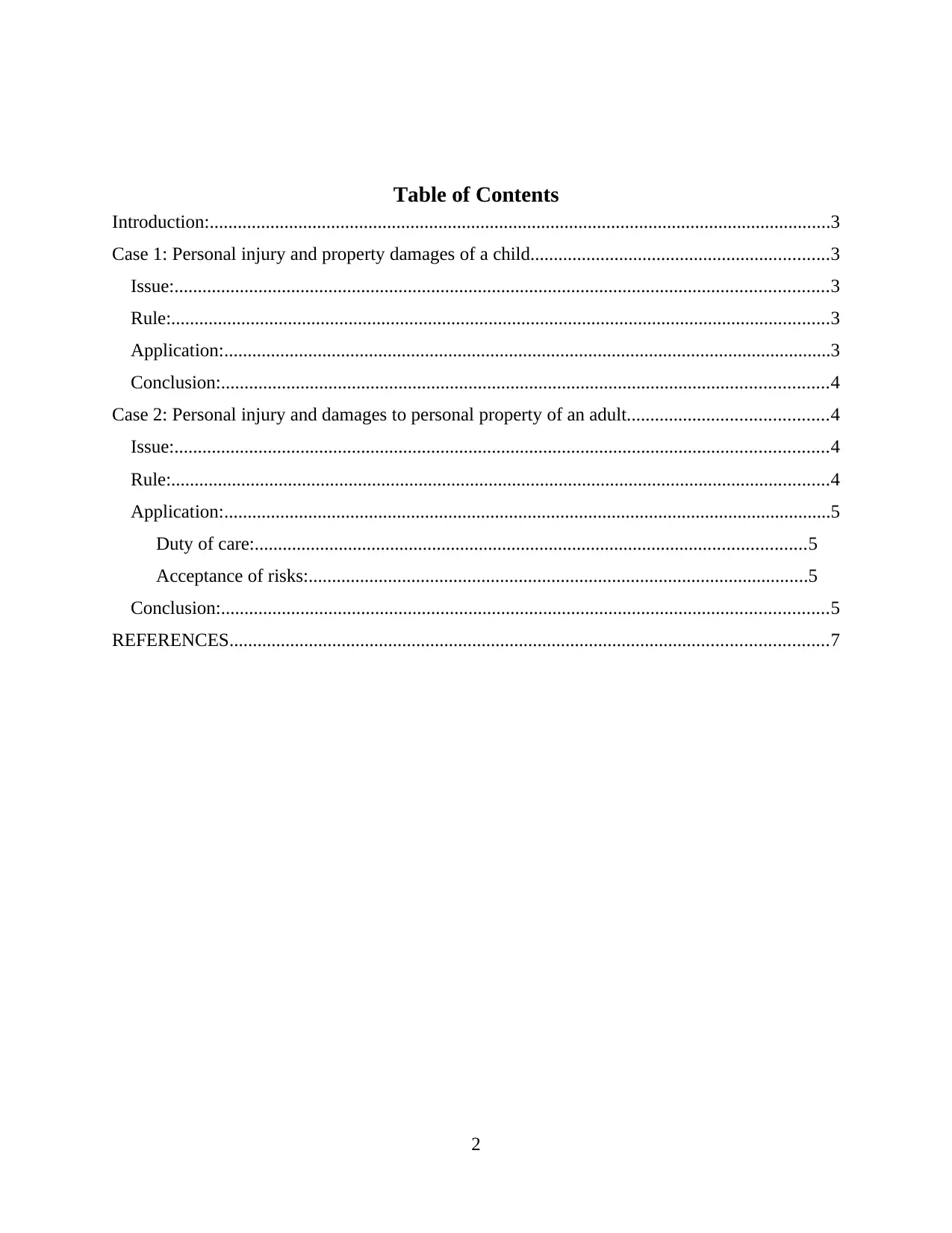
Table of Contents
Introduction:.....................................................................................................................................3
Case 1: Personal injury and property damages of a child................................................................3
Issue:............................................................................................................................................3
Rule:.............................................................................................................................................3
Application:..................................................................................................................................3
Conclusion:..................................................................................................................................4
Case 2: Personal injury and damages to personal property of an adult...........................................4
Issue:............................................................................................................................................4
Rule:.............................................................................................................................................4
Application:..................................................................................................................................5
Duty of care:......................................................................................................................5
Acceptance of risks:...........................................................................................................5
Conclusion:..................................................................................................................................5
REFERENCES................................................................................................................................7
2
Introduction:.....................................................................................................................................3
Case 1: Personal injury and property damages of a child................................................................3
Issue:............................................................................................................................................3
Rule:.............................................................................................................................................3
Application:..................................................................................................................................3
Conclusion:..................................................................................................................................4
Case 2: Personal injury and damages to personal property of an adult...........................................4
Issue:............................................................................................................................................4
Rule:.............................................................................................................................................4
Application:..................................................................................................................................5
Duty of care:......................................................................................................................5
Acceptance of risks:...........................................................................................................5
Conclusion:..................................................................................................................................5
REFERENCES................................................................................................................................7
2
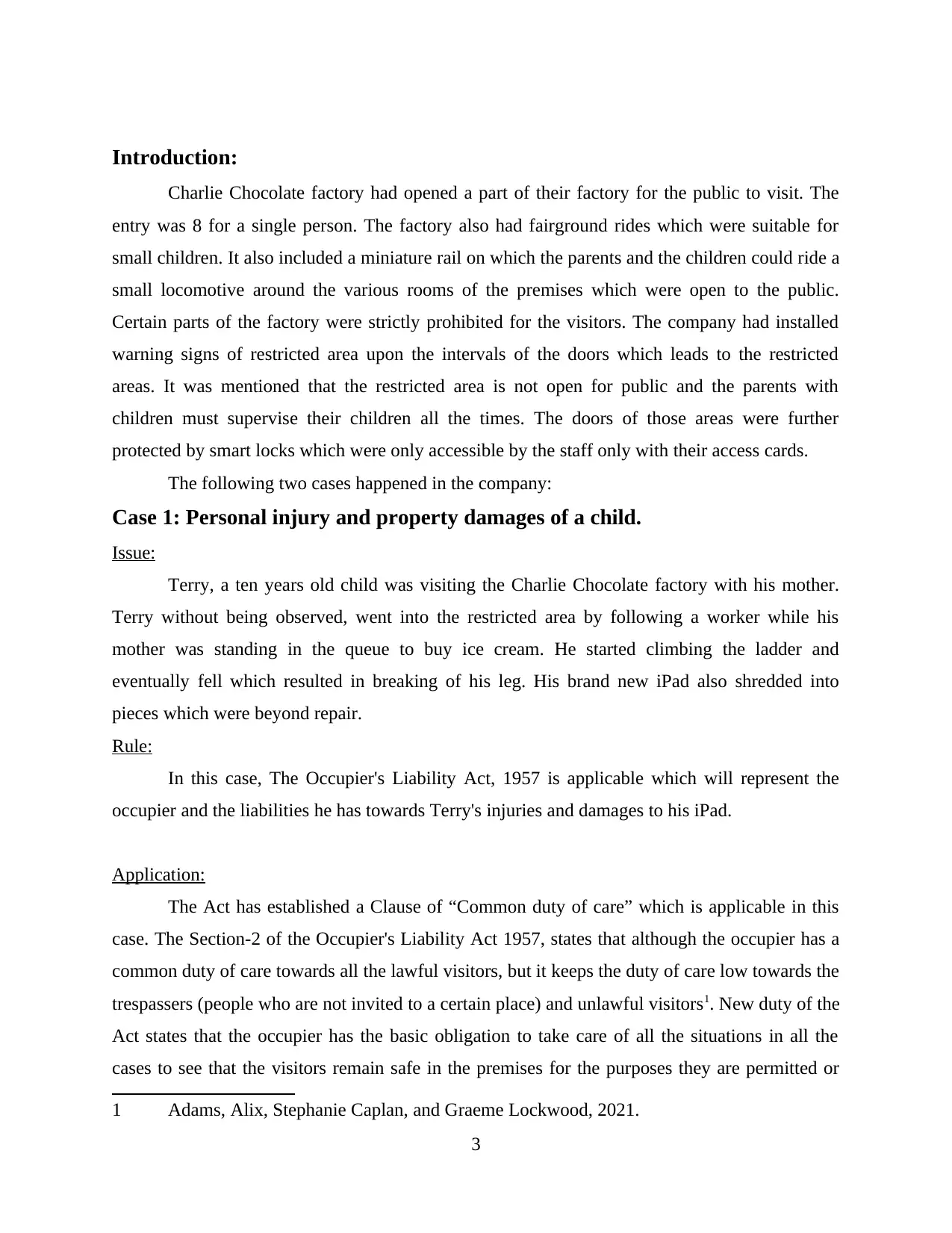
Introduction:
Charlie Chocolate factory had opened a part of their factory for the public to visit. The
entry was 8 for a single person. The factory also had fairground rides which were suitable for
small children. It also included a miniature rail on which the parents and the children could ride a
small locomotive around the various rooms of the premises which were open to the public.
Certain parts of the factory were strictly prohibited for the visitors. The company had installed
warning signs of restricted area upon the intervals of the doors which leads to the restricted
areas. It was mentioned that the restricted area is not open for public and the parents with
children must supervise their children all the times. The doors of those areas were further
protected by smart locks which were only accessible by the staff only with their access cards.
The following two cases happened in the company:
Case 1: Personal injury and property damages of a child.
Issue:
Terry, a ten years old child was visiting the Charlie Chocolate factory with his mother.
Terry without being observed, went into the restricted area by following a worker while his
mother was standing in the queue to buy ice cream. He started climbing the ladder and
eventually fell which resulted in breaking of his leg. His brand new iPad also shredded into
pieces which were beyond repair.
Rule:
In this case, The Occupier's Liability Act, 1957 is applicable which will represent the
occupier and the liabilities he has towards Terry's injuries and damages to his iPad.
Application:
The Act has established a Clause of “Common duty of care” which is applicable in this
case. The Section-2 of the Occupier's Liability Act 1957, states that although the occupier has a
common duty of care towards all the lawful visitors, but it keeps the duty of care low towards the
trespassers (people who are not invited to a certain place) and unlawful visitors1. New duty of the
Act states that the occupier has the basic obligation to take care of all the situations in all the
cases to see that the visitors remain safe in the premises for the purposes they are permitted or
1 Adams, Alix, Stephanie Caplan, and Graeme Lockwood, 2021.
3
Charlie Chocolate factory had opened a part of their factory for the public to visit. The
entry was 8 for a single person. The factory also had fairground rides which were suitable for
small children. It also included a miniature rail on which the parents and the children could ride a
small locomotive around the various rooms of the premises which were open to the public.
Certain parts of the factory were strictly prohibited for the visitors. The company had installed
warning signs of restricted area upon the intervals of the doors which leads to the restricted
areas. It was mentioned that the restricted area is not open for public and the parents with
children must supervise their children all the times. The doors of those areas were further
protected by smart locks which were only accessible by the staff only with their access cards.
The following two cases happened in the company:
Case 1: Personal injury and property damages of a child.
Issue:
Terry, a ten years old child was visiting the Charlie Chocolate factory with his mother.
Terry without being observed, went into the restricted area by following a worker while his
mother was standing in the queue to buy ice cream. He started climbing the ladder and
eventually fell which resulted in breaking of his leg. His brand new iPad also shredded into
pieces which were beyond repair.
Rule:
In this case, The Occupier's Liability Act, 1957 is applicable which will represent the
occupier and the liabilities he has towards Terry's injuries and damages to his iPad.
Application:
The Act has established a Clause of “Common duty of care” which is applicable in this
case. The Section-2 of the Occupier's Liability Act 1957, states that although the occupier has a
common duty of care towards all the lawful visitors, but it keeps the duty of care low towards the
trespassers (people who are not invited to a certain place) and unlawful visitors1. New duty of the
Act states that the occupier has the basic obligation to take care of all the situations in all the
cases to see that the visitors remain safe in the premises for the purposes they are permitted or
1 Adams, Alix, Stephanie Caplan, and Graeme Lockwood, 2021.
3
⊘ This is a preview!⊘
Do you want full access?
Subscribe today to unlock all pages.

Trusted by 1+ million students worldwide
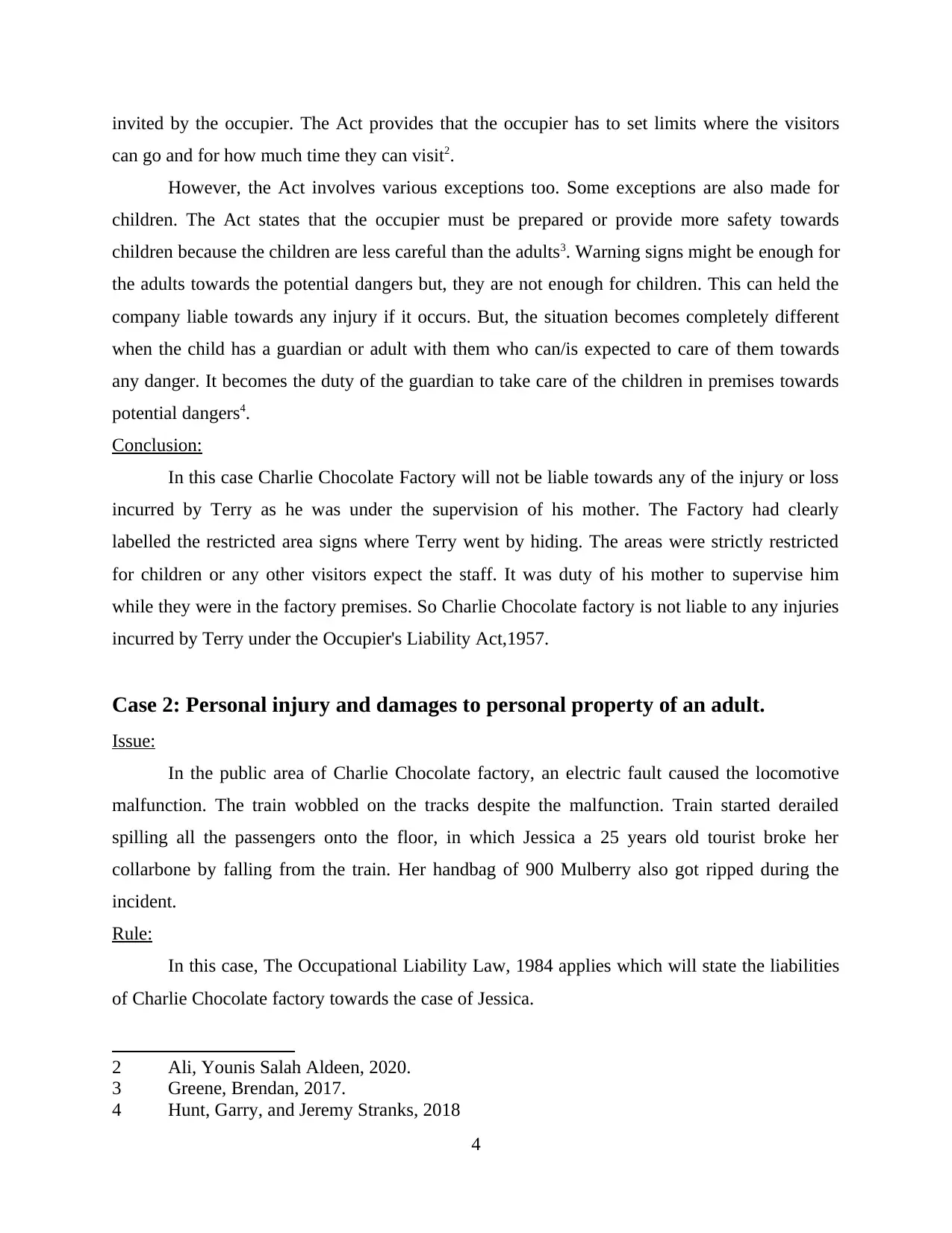
invited by the occupier. The Act provides that the occupier has to set limits where the visitors
can go and for how much time they can visit2.
However, the Act involves various exceptions too. Some exceptions are also made for
children. The Act states that the occupier must be prepared or provide more safety towards
children because the children are less careful than the adults3. Warning signs might be enough for
the adults towards the potential dangers but, they are not enough for children. This can held the
company liable towards any injury if it occurs. But, the situation becomes completely different
when the child has a guardian or adult with them who can/is expected to care of them towards
any danger. It becomes the duty of the guardian to take care of the children in premises towards
potential dangers4.
Conclusion:
In this case Charlie Chocolate Factory will not be liable towards any of the injury or loss
incurred by Terry as he was under the supervision of his mother. The Factory had clearly
labelled the restricted area signs where Terry went by hiding. The areas were strictly restricted
for children or any other visitors expect the staff. It was duty of his mother to supervise him
while they were in the factory premises. So Charlie Chocolate factory is not liable to any injuries
incurred by Terry under the Occupier's Liability Act,1957.
Case 2: Personal injury and damages to personal property of an adult.
Issue:
In the public area of Charlie Chocolate factory, an electric fault caused the locomotive
malfunction. The train wobbled on the tracks despite the malfunction. Train started derailed
spilling all the passengers onto the floor, in which Jessica a 25 years old tourist broke her
collarbone by falling from the train. Her handbag of 900 Mulberry also got ripped during the
incident.
Rule:
In this case, The Occupational Liability Law, 1984 applies which will state the liabilities
of Charlie Chocolate factory towards the case of Jessica.
2 Ali, Younis Salah Aldeen, 2020.
3 Greene, Brendan, 2017.
4 Hunt, Garry, and Jeremy Stranks, 2018
4
can go and for how much time they can visit2.
However, the Act involves various exceptions too. Some exceptions are also made for
children. The Act states that the occupier must be prepared or provide more safety towards
children because the children are less careful than the adults3. Warning signs might be enough for
the adults towards the potential dangers but, they are not enough for children. This can held the
company liable towards any injury if it occurs. But, the situation becomes completely different
when the child has a guardian or adult with them who can/is expected to care of them towards
any danger. It becomes the duty of the guardian to take care of the children in premises towards
potential dangers4.
Conclusion:
In this case Charlie Chocolate Factory will not be liable towards any of the injury or loss
incurred by Terry as he was under the supervision of his mother. The Factory had clearly
labelled the restricted area signs where Terry went by hiding. The areas were strictly restricted
for children or any other visitors expect the staff. It was duty of his mother to supervise him
while they were in the factory premises. So Charlie Chocolate factory is not liable to any injuries
incurred by Terry under the Occupier's Liability Act,1957.
Case 2: Personal injury and damages to personal property of an adult.
Issue:
In the public area of Charlie Chocolate factory, an electric fault caused the locomotive
malfunction. The train wobbled on the tracks despite the malfunction. Train started derailed
spilling all the passengers onto the floor, in which Jessica a 25 years old tourist broke her
collarbone by falling from the train. Her handbag of 900 Mulberry also got ripped during the
incident.
Rule:
In this case, The Occupational Liability Law, 1984 applies which will state the liabilities
of Charlie Chocolate factory towards the case of Jessica.
2 Ali, Younis Salah Aldeen, 2020.
3 Greene, Brendan, 2017.
4 Hunt, Garry, and Jeremy Stranks, 2018
4
Paraphrase This Document
Need a fresh take? Get an instant paraphrase of this document with our AI Paraphraser
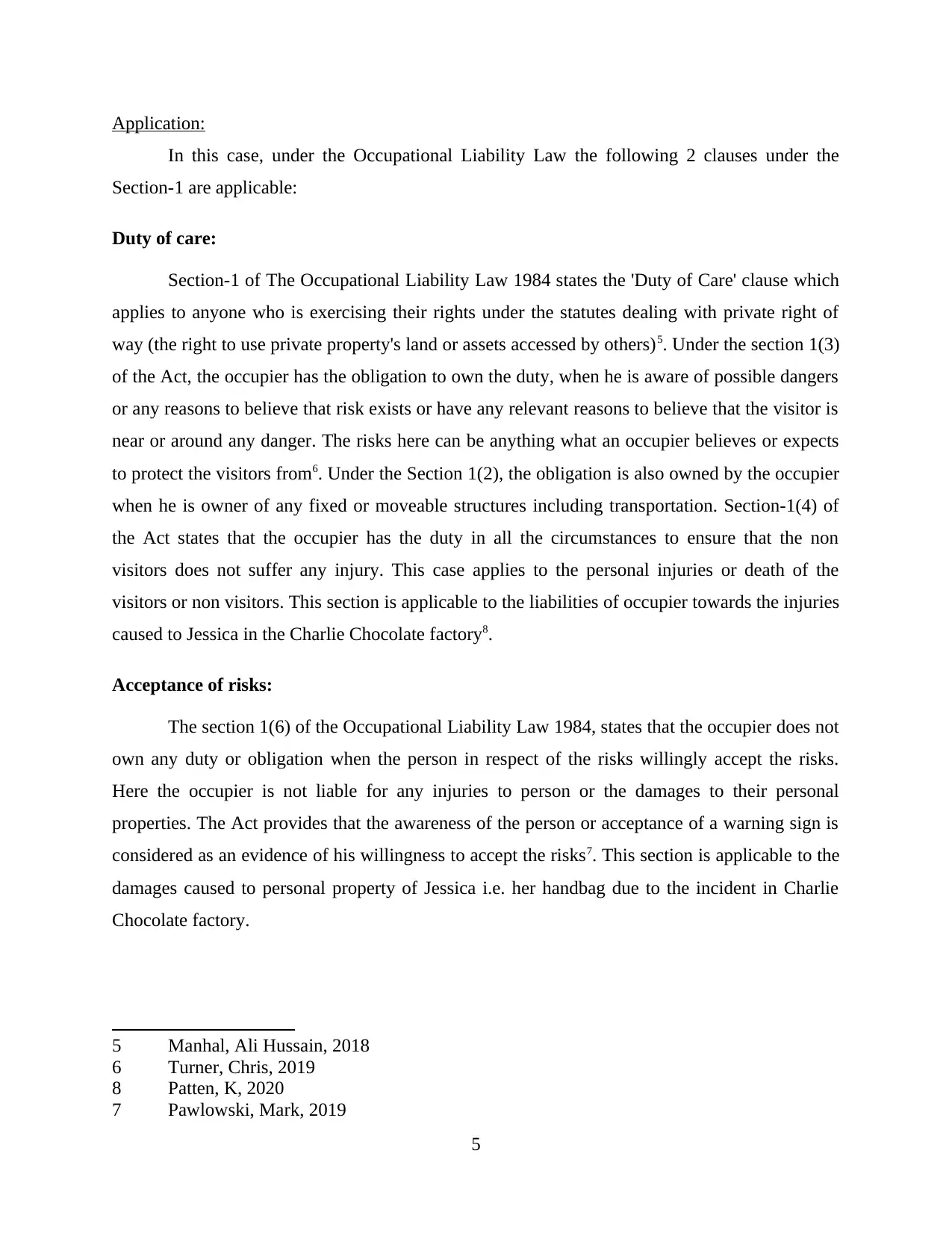
Application:
In this case, under the Occupational Liability Law the following 2 clauses under the
Section-1 are applicable:
Duty of care:
Section-1 of The Occupational Liability Law 1984 states the 'Duty of Care' clause which
applies to anyone who is exercising their rights under the statutes dealing with private right of
way (the right to use private property's land or assets accessed by others)5. Under the section 1(3)
of the Act, the occupier has the obligation to own the duty, when he is aware of possible dangers
or any reasons to believe that risk exists or have any relevant reasons to believe that the visitor is
near or around any danger. The risks here can be anything what an occupier believes or expects
to protect the visitors from6. Under the Section 1(2), the obligation is also owned by the occupier
when he is owner of any fixed or moveable structures including transportation. Section-1(4) of
the Act states that the occupier has the duty in all the circumstances to ensure that the non
visitors does not suffer any injury. This case applies to the personal injuries or death of the
visitors or non visitors. This section is applicable to the liabilities of occupier towards the injuries
caused to Jessica in the Charlie Chocolate factory8.
Acceptance of risks:
The section 1(6) of the Occupational Liability Law 1984, states that the occupier does not
own any duty or obligation when the person in respect of the risks willingly accept the risks.
Here the occupier is not liable for any injuries to person or the damages to their personal
properties. The Act provides that the awareness of the person or acceptance of a warning sign is
considered as an evidence of his willingness to accept the risks7. This section is applicable to the
damages caused to personal property of Jessica i.e. her handbag due to the incident in Charlie
Chocolate factory.
5 Manhal, Ali Hussain, 2018
6 Turner, Chris, 2019
8 Patten, K, 2020
7 Pawlowski, Mark, 2019
5
In this case, under the Occupational Liability Law the following 2 clauses under the
Section-1 are applicable:
Duty of care:
Section-1 of The Occupational Liability Law 1984 states the 'Duty of Care' clause which
applies to anyone who is exercising their rights under the statutes dealing with private right of
way (the right to use private property's land or assets accessed by others)5. Under the section 1(3)
of the Act, the occupier has the obligation to own the duty, when he is aware of possible dangers
or any reasons to believe that risk exists or have any relevant reasons to believe that the visitor is
near or around any danger. The risks here can be anything what an occupier believes or expects
to protect the visitors from6. Under the Section 1(2), the obligation is also owned by the occupier
when he is owner of any fixed or moveable structures including transportation. Section-1(4) of
the Act states that the occupier has the duty in all the circumstances to ensure that the non
visitors does not suffer any injury. This case applies to the personal injuries or death of the
visitors or non visitors. This section is applicable to the liabilities of occupier towards the injuries
caused to Jessica in the Charlie Chocolate factory8.
Acceptance of risks:
The section 1(6) of the Occupational Liability Law 1984, states that the occupier does not
own any duty or obligation when the person in respect of the risks willingly accept the risks.
Here the occupier is not liable for any injuries to person or the damages to their personal
properties. The Act provides that the awareness of the person or acceptance of a warning sign is
considered as an evidence of his willingness to accept the risks7. This section is applicable to the
damages caused to personal property of Jessica i.e. her handbag due to the incident in Charlie
Chocolate factory.
5 Manhal, Ali Hussain, 2018
6 Turner, Chris, 2019
8 Patten, K, 2020
7 Pawlowski, Mark, 2019
5
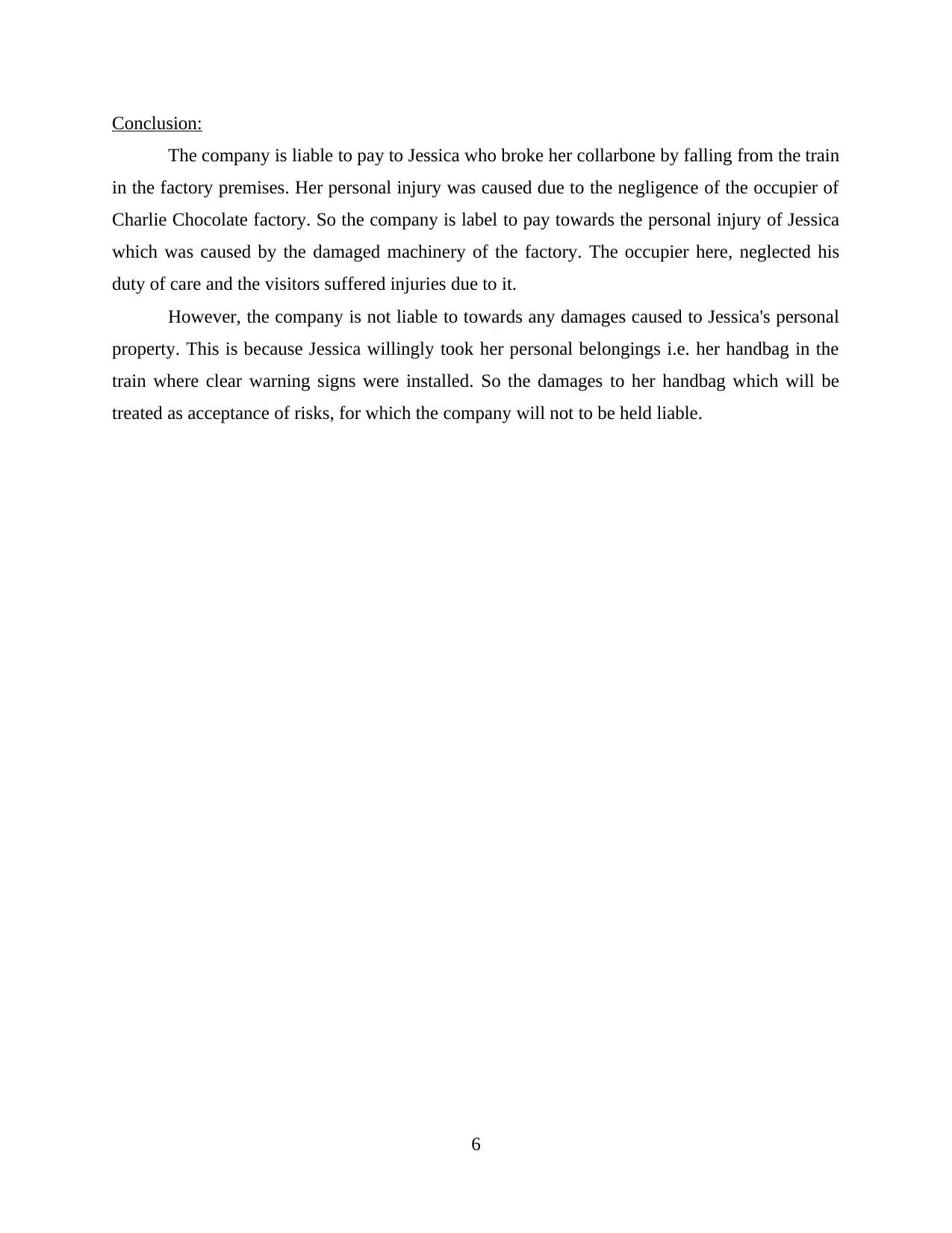
Conclusion:
The company is liable to pay to Jessica who broke her collarbone by falling from the train
in the factory premises. Her personal injury was caused due to the negligence of the occupier of
Charlie Chocolate factory. So the company is label to pay towards the personal injury of Jessica
which was caused by the damaged machinery of the factory. The occupier here, neglected his
duty of care and the visitors suffered injuries due to it.
However, the company is not liable to towards any damages caused to Jessica's personal
property. This is because Jessica willingly took her personal belongings i.e. her handbag in the
train where clear warning signs were installed. So the damages to her handbag which will be
treated as acceptance of risks, for which the company will not to be held liable.
6
The company is liable to pay to Jessica who broke her collarbone by falling from the train
in the factory premises. Her personal injury was caused due to the negligence of the occupier of
Charlie Chocolate factory. So the company is label to pay towards the personal injury of Jessica
which was caused by the damaged machinery of the factory. The occupier here, neglected his
duty of care and the visitors suffered injuries due to it.
However, the company is not liable to towards any damages caused to Jessica's personal
property. This is because Jessica willingly took her personal belongings i.e. her handbag in the
train where clear warning signs were installed. So the damages to her handbag which will be
treated as acceptance of risks, for which the company will not to be held liable.
6
⊘ This is a preview!⊘
Do you want full access?
Subscribe today to unlock all pages.

Trusted by 1+ million students worldwide
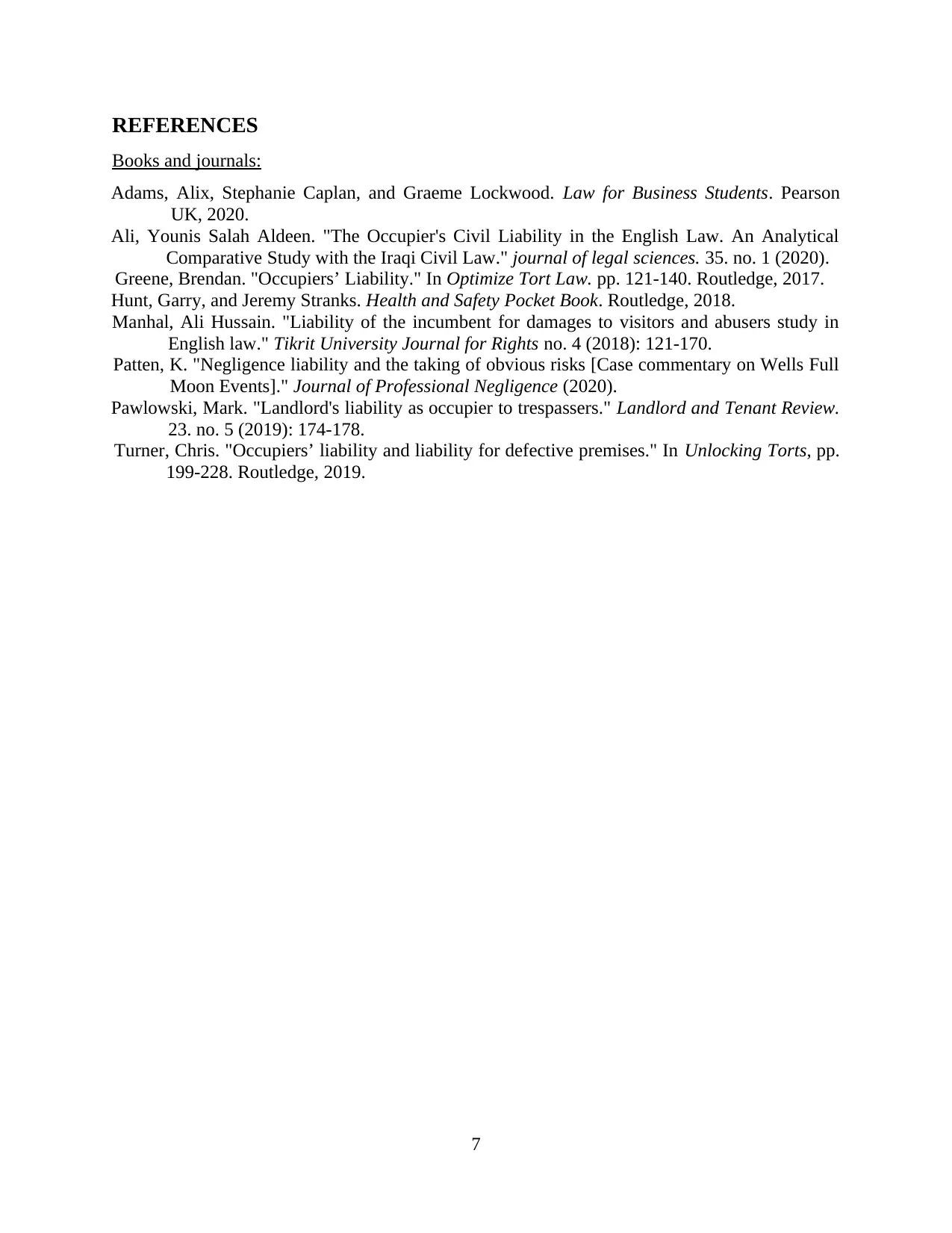
REFERENCES
Books and journals:
Adams, Alix, Stephanie Caplan, and Graeme Lockwood. Law for Business Students. Pearson
UK, 2020.
Ali, Younis Salah Aldeen. "The Occupier's Civil Liability in the English Law. An Analytical
Comparative Study with the Iraqi Civil Law." journal of legal sciences. 35. no. 1 (2020).
Greene, Brendan. "Occupiers’ Liability." In Optimize Tort Law. pp. 121-140. Routledge, 2017.
Hunt, Garry, and Jeremy Stranks. Health and Safety Pocket Book. Routledge, 2018.
Manhal, Ali Hussain. "Liability of the incumbent for damages to visitors and abusers study in
English law." Tikrit University Journal for Rights no. 4 (2018): 121-170.
Patten, K. "Negligence liability and the taking of obvious risks [Case commentary on Wells Full
Moon Events]." Journal of Professional Negligence (2020).
Pawlowski, Mark. "Landlord's liability as occupier to trespassers." Landlord and Tenant Review.
23. no. 5 (2019): 174-178.
Turner, Chris. "Occupiers’ liability and liability for defective premises." In Unlocking Torts, pp.
199-228. Routledge, 2019.
7
Books and journals:
Adams, Alix, Stephanie Caplan, and Graeme Lockwood. Law for Business Students. Pearson
UK, 2020.
Ali, Younis Salah Aldeen. "The Occupier's Civil Liability in the English Law. An Analytical
Comparative Study with the Iraqi Civil Law." journal of legal sciences. 35. no. 1 (2020).
Greene, Brendan. "Occupiers’ Liability." In Optimize Tort Law. pp. 121-140. Routledge, 2017.
Hunt, Garry, and Jeremy Stranks. Health and Safety Pocket Book. Routledge, 2018.
Manhal, Ali Hussain. "Liability of the incumbent for damages to visitors and abusers study in
English law." Tikrit University Journal for Rights no. 4 (2018): 121-170.
Patten, K. "Negligence liability and the taking of obvious risks [Case commentary on Wells Full
Moon Events]." Journal of Professional Negligence (2020).
Pawlowski, Mark. "Landlord's liability as occupier to trespassers." Landlord and Tenant Review.
23. no. 5 (2019): 174-178.
Turner, Chris. "Occupiers’ liability and liability for defective premises." In Unlocking Torts, pp.
199-228. Routledge, 2019.
7
1 out of 7
Related Documents
Your All-in-One AI-Powered Toolkit for Academic Success.
+13062052269
info@desklib.com
Available 24*7 on WhatsApp / Email
![[object Object]](/_next/static/media/star-bottom.7253800d.svg)
Unlock your academic potential
Copyright © 2020–2025 A2Z Services. All Rights Reserved. Developed and managed by ZUCOL.





